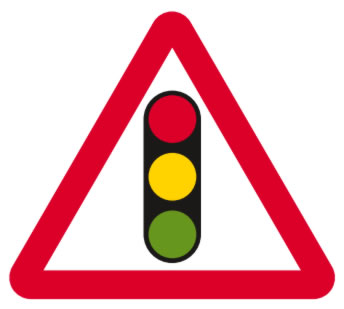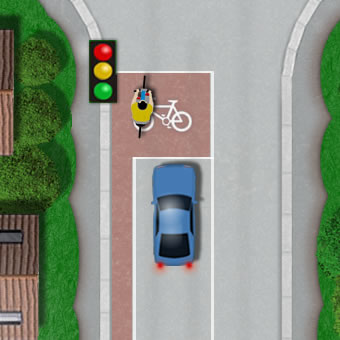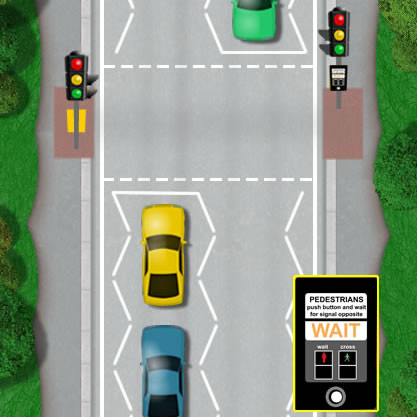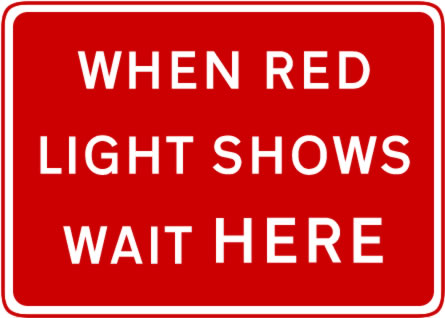Learning how to deal with and anticipate traffic lights takes time and practice. Understanding traffic lights and dealing with them correctly is essential to safe driving and is of course necessary to pass the driving test.
As UK roads get busier, a greater number of traffic lights are needed to safely control and organise UK roads. Although most of them follow a similar principle and sequence, it’s important to understand the different types of traffic lights.
This tutorial explains the different types of traffic lights, how to approach traffic lights and how to deal with them during a driving test.
How traffic lights work
How traffic lights work depends on the type of traffic signal, although each traffic light is controlled by a computer located in a metal housing box cabinet at the side of the road. When for example your light turns green, this is called a phase and a combination of phases for example your light runs through the entire red, amber and green lights is called a stage.
All the stages and phases are programmed into the computer so not to cause conflict with each other and timed appropriately depending on the time of day and how busy a particular road is.

Traffic light failure
Software within the computer continuously monitors the green light phases to ensure there are no conflicts – for instance north bound and east bound would need to run at alternative stages else collisions would occur. If the software detects both green phases simultaneously, it will shut the entire system down for that particular set of traffic lights.
This will leave motorists the responsibility of dealing with the junction as all lights will remain extinguished. When traffic lights are out of action, no one has priority and motorists should abide by the stop line and proceed with extreme caution.
Approaching traffic lights
There are so many things to think about whilst learning to drive. Controlling the car and keeping an eye on what’s going on around you is difficult. As you gain in experience it will begin to get significantly easier and you will need to improve your anticipation and planning skills.
As you are driving, you will need to keep a check of your immediate surroundings, but also down the road as far as you can see. In the distance you may locate traffic lights and plan accordingly as you approach giving you plenty of time. Approaching traffic lights, you will need to determine what type of traffic system it is. A junction / crossroads / roundabout or pedestrian crossing.
As you are approaching traffic lights, if they have been on a green phase for some time, chances are they will change. On your approach, if you notice a person or people close to the lights, it’s likely a pedestrian crossing.
You may also notice the yellow box where the button that pedestrians need to press is located, or even notice the ‘WAIT’ light illuminated on the yellow box. Use whatever you can to assess what it is and to help anticipate what may happen.
At the earliest, try to locate any lane road markings or other road markings that may have lanes or directional arrows and use these to establish what road position you need. Apply the MSPSL routine as you get closer.
Wrong lane at traffic lights
If on a driving test and you find yourself in the wrong lane at traffic lights, as you approach the lights try if possible to get into the correct lane. It is essential that you only do this this if it is safe to do so. To do this you will need to apply the MSPSL routine again and look into the blind spot on the side you are moving over to. Vast amounts of driving test are failed due to lane changes without the correct observations and/or changing lanes when it should not have been done.
If in any doubt whether it is safe to move lanes or you don’t have enough time to use all the correct observations and signals, remain in the incorrect lane. You will not fail the test for taking the wrong lane at traffic lights as it’s not a test of your navigational skills. Simply keep it safe and the driving examiner will take you on an alternative part of the driving test routes.
Stopping at traffic lights
Traffic light advanced stop lines and cycle boxes
When stopping at traffic lights at a junction, stop just before the first white line on an advanced stop line where cycle boxes are located. If your vehicle is traveling slowly and the lights change just as you move over the first stop line, you must stop at the second line and remain in the cycle box area. This isn’t an ideal situation, especially in a driving test although in slow moving traffic it can occasionally happen.

To reduce the possibility of this happening, leave enough room from the vehicle in front so that when you move into the cycle box area you will have enough room the other side to clear this area. If the lights change just as you enter the box, the priority must be to stop at a red or amber light and not to clear the cyclist box.
Pedestrian crossing traffic lights
Although the law can be a little more lenient on motorists stopping in cycle boxes, stopping over a pedestrian crossing stop line can be a more punishable offence and one that is certainly likely to fail a driving test.

If traffic is moving slowly, to avoid stopping over a pedestrian crossing, ensure that you leave enough distance from the vehicle in front to completely clear the crossing before proceeding ahead. Some pedestrian crossing use cameras to detect vehicles that stop on the crossing area which results in the driver receiving a fine and penalty point – this includes learner drivers.
Traffic light sequence
See traffic light sequence to gain a better understanding of the light sequences. See also Pelican crossing and Puffin crossing for an understanding for pedestrian crossing light sequences and how they differ from standard traffic lights.

Temporary traffic lights
Temporary traffic light rules are the same as permanent traffic lights. Where the red temporary traffic lights sign ‘ When red light shows wait here’ is situated, marks the position of the stop line on permanent traffic lights.
